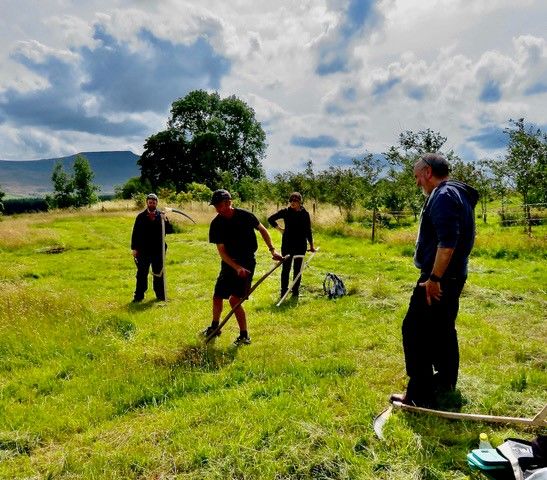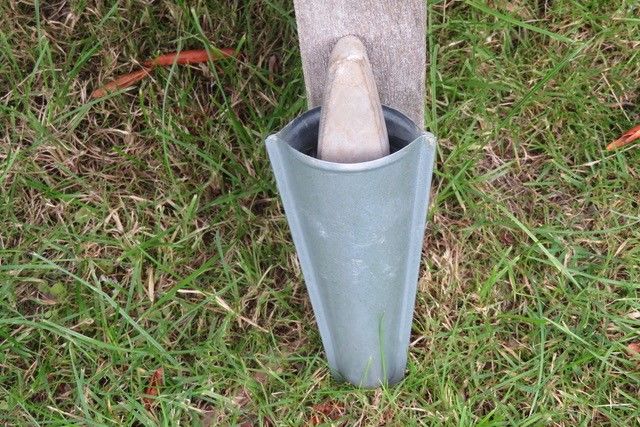“Turn right at the fifth cattle grid,” the instruction said. I gripped my car’s steering wheel, refusing to admit I was lost. I had never received directions based on cattle grids before.
It was the Yorkshire Dales, and each side of me was a scenic mountain, Ingleborough right and Whernside left, as I hunted for the bunkhouse where I had been told to report. Mobile signal? No chance. The only sign of alternative life was a bleating lamb trapped by hawthorn in a nearby field. Meanwhile my satellite navigation thought I was on the Isle of Man. I went back to counting cattle grids, as even I could count to five.

I glanced in my rear-view mirror when I heard a metallic chink. The scythe, which came from rural Austria, was sharp, curved, and threatening and lay across the back seat. I watched it bounce gently as I negotiated the potholed track. I had bought it ten days earlier, although had no clue what to do with it. Learning to scythe had seemed sensible, as fuel-powered garden machinery had been receiving bad press. A petrol-driven mower, when used for 25 hours each year – the national average – has the same polluting effect as driving 3750 kilometres in a car. There was also the Poldark image, which I secretly craved. The television star had been screened bare chested while wielding a scythe and the world had swooned. Now it was my turn.
My brief attempt to scythe the long grass of my renatured Lake District garden had shown me that there is a knack to the technique. Not everyone can do it. I had been excellent at flattening grass but hopeless at cutting. Our forefathers made it look easy, but the reality was different, so it was time to learn from a professional. The bunkhouse I was seeking was the location for a day-long scything course, although I doubted a day would be sufficient to drag me from beginner status.
Thanks to the climate catastrophe, scything is making a comeback. Every year, the British buy 1500 scythes, each powered by muscle, not fossil fuel. A scythe is easy to store, requires little maintenance, cuts silently, spills no oil on a garden, and costs nothing to run once purchased. It loves long grass, particularly if it is wet. Courses are filled weeks in advance, and I had been lucky to find a place. Scything, mowing is the proper term, has been practised since Neolithic times when early scythes were made of stone. These days it is steel alloy. Using a scythe takes time and patience.


“Come far?” asked Steve, my tutor for the day, after I had rounded a final corner to see the bunkhouse. He had been mowing for an easy decade and had turned the implement into an artform.
I was about to mumble, “Too far,” when I saw the scythe he was holding. You do not upset a tutor with a scythe, so I smiled, said nothing, and joined the course.
There were nine of us in total, each conservation crazy, and from throughout the country. Lesson One was carrying the scythe without losing a finger. My blade was 65 centimetres long, some can be nearly double, so digits do take fright.
A scythe can also be a weapon. War scythes were widely used throughout history, particularly in peasant uprisings. The pole, or snaith, was longer than today’s variety, but its blade was shorter and won many battles. To carry a scythe safely, it is best to hold it horizontally, by its snaith, blade forwards and pointing down. That way, you should preserve your fingers.
I was a useless mower and Steve immensely patient. When we moved to Lesson Two, and I was asked to mow a meadow, scissors might have been simpler. Swishing right to left, the long grass remained intact. Meanwhile my colleagues made it appear easy, their cut grass lying in long heaps, known as windrows.

“Bum!” Steve shouted towards me.
“Bum?” I asked.
“Pull the snaith, don’t push. Pull it round to your buttock.”
Which I did, and the grass fell away as the scythe did its work. Until Steve’s next instruction.
“Sharpen!”
“It has only been ten minutes,” I replied.
“Too long. You need as much time sharpening as mowing. I’ll show you.”
Steve removed the oval whetstone from his belted sheath, took my scythe and started.

Scratch, rasp and scrape. He worked hard on the blade, and two minutes later the scythe was razor sharp. The meadow did not stand a chance. Swish, swish, then followed and anything vertical collapsed before me. There was no resistance.
Six hours later I was accredited, although by the course’s end I knew I was at the beginning. Mowing like our forefathers takes time to develop, although works wonders for conservation.
***
If you go…
Location
This scythe course was based at Broadrake Bunkhouse, which is at:
Broadrake
Chapel-le-Dale
Ingleton
LA6 3AX
Grid reference: SD740792
Latitude/longitude: 54.2079N, 2.3995W
What3Words: ///consumed.ideals.tactical
The course was run by Steve Tomlin of Steve Tomlin Crafts (https://stevetomlincrafts.co.uk/learn-to-scythe/)
Cost: £100
Timings: 1000-1700hrs
Steve Tomlin holds courses at Slaidburn (Lancashire), Sedbergh (Cumbria), and Chapel-le-Dale (Yorkshire), and offers private tuition to both individuals and groups. Ask him at stevetomlin8@gmail.com.
It is possible to buy a scythe kit on the day, or at any other time, directly from Steve Tomlin (https://stevetomlincrafts.co.uk/buy-a-scythe-kit/). Cost is £180.
Getting there
Find the Old Hill Inn on the B6255 at Chapel-le-Dale, turn down the single-track Philpin Lane, and follow the directions at http://broadrake.co.uk/directions.html.
Distances:
London (274 miles); Manchester (65 miles); Kendal (24 miles); Bristol (230 miles); Edinburgh (166 miles); York (71 miles)
Ribblehead Station (2.5 kms away), on the Settle-Carlisle line (https://settle-carlisle.co.uk), is less than one hour’s walk from Broadrake.
Dalesbus (https://www.dalesbus.org) goes to Ribblehead and Ingleton (7.7 kms away). Occasional buses (830, 831) stop at The Old Hill Inn in Chapel-le-Dale (2 kms away).
Where to stay
Broadrake
Address: Broadrake, Chapel-le-Dale, Ingleton, LA6 3AX
Self-catering, bunkhouse accommodation, with free fast wifi
Email: info@broadrake.co.uk
Telephone: 01524 241357
The Royal Hotel
Address: 26 Main St, Kirkby Lonsdale, Carnforth, LA6 2AE
Email: info@royalhotelkirkbylonsdale.co.uk
Telephone: 01524 271966
Web: https://www.royalhotelkirkbylonsdale.co.uk
Hipping Hall
Address: Cowan Bridge, Kirkby Lonsdale, Carnforth, LA6 2JJ
Email: info@hippinghall.com
Telephone: 01524 271187
Web: https://www.hippinghall.com
Eating there
The Old Hill Inn
Address: Chapel-le-Dale, Ingleton, North Yorkshire, LA6 3AR
Email: info@oldhillinningleton.co.uk
Telephone: 01524 241256
Web: http://www.oldhillinningleton.co.uk/index.html
The Old Hill Inn also has two rooms, a caravan site and two glamping pods
The Station Inn
Ribblehead
Address: Low Sleights Road, Carnforth, LA6 3AS
Email: bookings@thestationinnribblehead.com
Telephone: 01524 241274
Web: https://www.thestationinnribblehead.com
The Station Inn also has rooms and bunkhouses
Bernie’s of Ingleton
Address: 4. Main Street, Ingleton, North Yorkshire, LA6 3EB
Email: louise@smarttiming.co.uk
Tel. 07507 388736
Other things to see
St Leonard’s Chapel
Only 48 feet long and 20 feet wide. Peace, tranquillity, and beauty.
Address: St Leonard’s Church, Oddies Lane, Chapel-le-Dale, Ingleton, Carnforth, LA6 3AR
Email: nick.trenholme@gmail.com
Telephone: 01524 241924
Web: https://www.ingleboroughchurches.org.uk/chapel-le-dale
Walk the Three Peaks
A circular route that takes in the three peaks of Ingleborough, Pen-y-Ghent and Whernside. Start the trail anywhere but it is only a field away from Broadrake Bunkhouse.
Starting from Ingleton makes the Three Peaks Challenge 29.5 miles long. The traditional route starts at Chapel-le-Dale (LA6 3AR), Horton-in-Ribblesdale (BD24 0HE), or Ribblehead (LA6 3AS) and is 24.5 miles long.
Web: https://www.yorkshirepeakschallenge.co.uk; https://www.threepeakschallenge.uk/yorkshire-three-peaks-challenge/route
White Scar Cave
The longest show cave in Britain. Try the Battlefield Cavern with its thousands of stalactites.
Open daily from 1000hrs July-October; weekends only November-February
Price: £12 (adults); £8 (children – free under 3 years); £34 (family)
Address: Ingleton, North Yorkshire, LA6 3AW
Email: info@whitescarcave.co.uk
Telephone: 01524 241244
Web: https://whitescarcave.co.uk
Ingleton Waterfalls Trail
Open daily, apart from Christmas Day. Opening time is 0900hrs but closing time varies. Limited free parking. Price: £8 (adults); £4(children)
Address: Broadwood Entrance, Ingleton, North Yorkshire, LA6 3ET
Email: info@ingletonwaterfallstrail.co.uk
Telephone: 01524 241930 (ticket office)
Web: https://www.ingletonwaterfallstrail.co.uk
Further information
Scythe Association – http://scytheassociation.org
parking. Price: £8 (adults); £4(children)
Address: Broadwood Entrance, Ingleton, North Yorkshire, LA6 3ET
Email: info@ingletonwaterfallstrail.co.uk
Telephone: 01524 241930 (ticket office)
Web: https://www.ingletonwaterfallstrail.co.uk
Further information
Scythe Association – http://scytheassociation.org
Visitor information (Yorkshire Dales):











